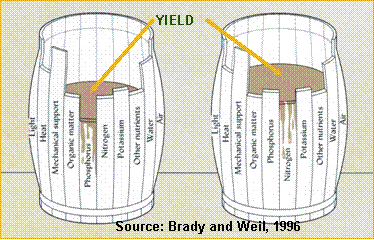Competency Area 3: Soil Testing and Plant Tissue Analysis
PO 18. Compare and contrast the following approaches for making fertilizer recommendations:
- Sufficiency level
- Soil buildup and maintenance
- Cation saturation ratios
Three main approaches have been developed to determining nutrient status and calculating needs.
Sufficiency level recommendations are most commonly used by Land Grant Universities and their laboratories. The recommendations utilize the yield response method; i.e. fertilizer rate is based on expected crop response (i.e. increased yield), a function of soil nutrient levels. The agronomic soil test is an index that can be used, based on a large amount of local field studies, to determine:
- If a response to extra fertilizer is to be expected
- How much of that fertilizer needs to be added
Results from soil tests are categorized as being either "high," "medium," or "low" for a given nutrient. Crops in high-test soils are unlikely to demonstrate any yield response to additional fertilizer; crops in medium-test soils may or may not show a yield response; and crops in low-test soils are likely to respond to additional nutrients. Fertilizer recommendations are made appropriately. Overall, this method of recommendation leads to a slower increase in soil test values, and keeps the soil test values lower than result from other methods. This is primarily due to a decreased fertilizer usage than in the other approaches.
The limiting factor concept is utilized in the sufficiency level method of making nutrient recommendations. It states that crop yield increases will cease when a nutrient or factor "runs out;" i.e. it cannot promote further increases. When that factor is supplied, yield will increase until another factor becomes limiting. The first limiting factor is the component lacking first; the second and third limiting factors are those that only come into play after the first has been amended. In the below example, each plank of the barrel represents one of the essential components of plant growth. The fill of the barrel represents yield. At first, phosphorus is limiting; once there is not enough P to go around, yield cannot increase further. Once more P has been added, yield can increase until it hits the next-limiting nutrient (in this case, N).
 |
The limiting factor concept is utilized in the sufficiency level method of making nutrient recommendations. It states that crop yield increases will cease when a nutrient or factor "runs out;" i.e. it cannot promote further increases. When that factor is supplied, yield will increase until another factor becomes limiting. The first limiting factor is the component lacking first; the second and third limiting factors are those that only come into play after the first has been amended. In the below example, each plank of the barrel represents one of the essential components of plant growth. The fill of the barrel represents yield. At first, phosphorus is limiting; once there is not enough P to go around, yield cannot increase further. Once more P has been added, yield can increase until it hits the next-limiting nutrient (in this case, N).
|
Soil buildup and maintenance recommendations aim to evaluate soil nutrient levels, alter these levels via fertilization and/or crop removal until they are at an optimal level, and then maintain that level. Fertilization is heavy and quick, increasing soil test values rapidly over a few years, and then the subsequent maintenance fertilizer applications are made to crop removal levels. The buildup part of the recommendation is determined by the expected crop response to the added nutrients. Fertilizer recommendations are made using an index, which predicts yield response ased on soil test levels and different application rates. The maintenance part of the recommendation is based on replacing the amount of nutrient expected to be removed by the crop. This should keep the soil test level from falling below optimum between soil tests. When the soil test reaches a level where crop removal will not reduce the soil test level to below optimum, no additional nutrients are added. The crop is allowed to draw the nutrient levels down into the optimum range. While this method is fairly simple, it ignores non-agronomic losses of nutrients (leaching, volatilization, etc.) and requires knowledge of crop nutrient content.
Cation saturation ratios are not commonly used as the basis for nutrient recommendations. The process assumes there is an ideal distribution of exchangeable cations (Ca, Mg and K) on the CECand that when th enutreints are in balance, the soil solution ensures adequate nutrient availability to plants. The most commonly applied ratio is: 65% Ca, 10% Mg, 5% K, and 20% misc. It should be noted that especially for calcareous (high pH) soils, adjustments to particular ratios can be very expensive, and saturation estimates (particularly for K) are not reliable. Also research has shown that if the soil pH and the soil test K and Mg levels are optimum, further adjustments to cation saturations on the CEC are unnecessary. |
Quick Links
- Competency Area 1: Basic Concepts of Plant Nutrition
- Competency Area 2: Basic Concepts of Soil Fertility
- Competency Area 3: Soil Testing and Plant Tissue Analysis
- Competency Area 4: Nutrient Sources, Analyses, Application Methods
- Competency Area 5: Soil pH and Liming
- Competency Area 6: Nutrient Management and Planning
